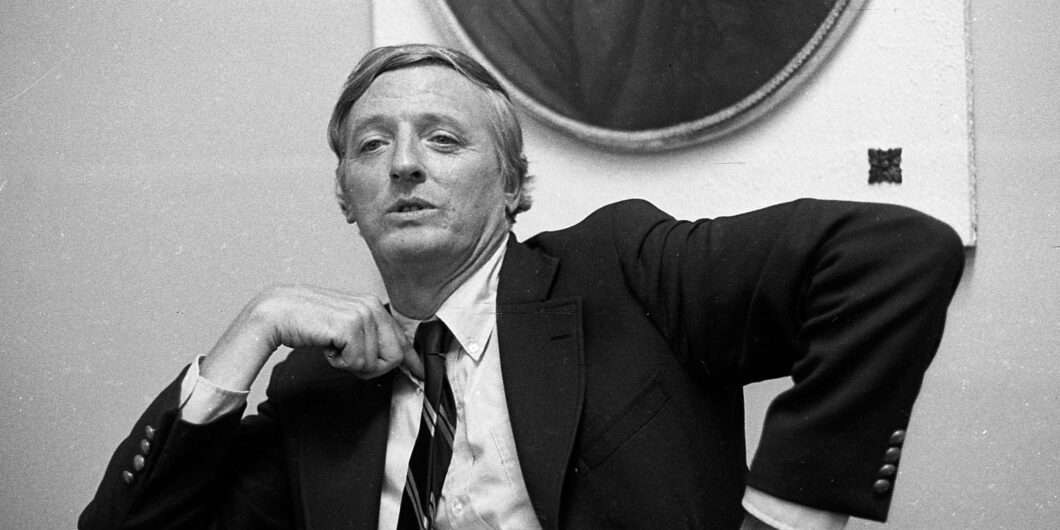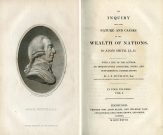Steering Right
The art of biography from Plutarch onwards shows how character is destiny. And superb books in the genre show how that character was shaped by upbringing and environment. In this respect, Sam Tanenhaus’s Buckley: The Life and the Revolution That Changed America is magnificent. Tanenhaus shows in detail “how everything Buckley learned and everything he became began at home.”
A middle child in a pack of ten, he had to become a performer from the start simply to be heard over his siblings. In such an articulate and rambunctious family, the young Buckley cultivated his innate talents for listening and then responding with witty repartee. From a father who was a wildcatter, as often on the cusp of bankruptcy as of great wealth, he inherited a risk-taking, almost swashbuckling, persona. Even his famous transatlantic accent was not a later life affectation but a holdover from his formative years at a British boarding school, one of the many stops in a meandering journey of early learning.
And most of all, he grew up a cradle conservative. While his family’s principal residence was in Connecticut, his parents were emphatically not Yankees. His father was the son of a Texas sheriff, and his mother the daughter of a Louisianian cotton broker. His father hated the New Deal, and the Buckley children competed to improve on their father’s denunciations. Thus, when Buckley arrived at Yale, he had the preparation and confidence to astonish his classmates by making powerful arguments against his liberal professors on politically and economically contentious topics. But despite his verbal facility, Buckley did not become a scholar. He absorbed ideas quickly in conversation but rarely pursued their depths through sustained study. What made him the biggest man on campus was the brio of his chairmanship of the Yale Daily News, not the originality of his academic contributions.
This background prepared him for what he became—the greatest controversialist in the nation and the broker of the most important political movement of his time, transforming conservatism from a moribund and reactionary philosophy to an effective ideology of governance. Tanenhaus is at his best in describing the sheer improbability of the achievement. Republicans had enjoyed substantial success in electing Eisenhower, a Republican, but not a man of the right, because he had made his peace with the New Deal. But Buckley recognized this kind of Republicanism would merely prove an interregnum between eras of increasing liberalism. The right needed to argue for a fundamentally distinct set of principles, not merely slow the implementation of the consensus liberalism of the time.
Just as his father had the confidence to drill where there was no assurance of striking oil, Buckley was willing to set up National Review as a conservative magazine of opinion where there was a likelihood of failure. He assembled a group of writers that encompassed the entire spectrum of conservative opinion from traditionalist Russell Kirk to fusionist Frank Meyer to the ex-Marxist, anticommunist dialectician James Burnham. These were a cacophony of voices, but Buckley here, too, was a good listener, allowing each to make his case in the magazine and making a politically astute synthesis of his own. Buckley’s empathetic nature enabled the kind of open tent that modern conservatism required if it was to corral different factions to create an effective movement.
But Buckley also recognized that he needed to police the boundaries of conservatism, keeping out the crazies and extremists. Tanenhaus shows how he outmaneuvered Joseph Welch and the John Birch Society, exiling them from the respectable right. Much later, he would do the same to its strand that threatened to be antisemitic, represented by the mercurial Joseph Sobran.
He was also willing to put his money where his mouth was. Journals of opinions are notorious financial sinkholes. And thus, Buckley needed to first support National Review with family resources and then with speaking engagement fees. But no political magazine has ever earned such a good return on investment.
As Buckley made conservatism a vibrant intellectual force, it attracted a new generation who had tired of consensus liberalism. While much of the literature on the 1960s has focused on the SDS and other left rebels, Buckley midwifed the Young Americans for Freedom, who set forth their charter at his estate. His brother-in-law and fellow NR contributor, Brent Brozell, ghostwrote Barry Goldwater’s Conscience of a Conservative, the book which propelled him to the 1964 Republican presidential nomination. Goldwater lost the election in a landslide but made Republicans, for the first time in a generation, an indisputably conservative party. Tanenhaus rightly credits Buckley as the single most important architect of conservatism’s twentieth-century revival.
Even a great biography has its flaws. Tanenhaus is a liberal, and sometimes out of his depth or out of sorts in addressing conservatism.
In the face of disagreement with other conservatives, including many at NR, Buckley backed Nixon in 1968. This move was a matter of calculation: he did not believe the newly elected Governor Ronald Reagan was ready to be a successful national candidate. Buckley’s pragmatic dictum to support the most electable conservative candidate (surprisingly not quoted by Tanenhaus) was decisive here. When Nixon was elected, Buckley enjoyed substantial influence: Nixon needed him to protect his right flank. Tanenhaus shrewdly contrasts his ready access with the more standoffish treatment he received in the Reagan administration. Reagan did not need the magazine’s protection and may have been annoyed by National Review’s announcement on his election that “we now have a country to run.” Reagan was a far shrewder and more calculating politician than most observers ever realized.
For all his successes, Buckley had his limitations. Tanenhaus is correct that he was not an original “thinker, still less a theorist.” But a complex society enjoys a division of intellectual as well as physical labor. Men like Friedrich Hayek were deep thinkers, but they were not great controversialists. Milton Friedman was both, but he did not have the encompassing vision and charisma to renew and hold together a political movement.
Buckley was also late in embracing equal rights for African Americans. This flaw, too, stemmed from his upbringing. His parents were Southern paternalists when it came to race. They treated their black servants so well that descendants of those servants had tears in their eyes when they described the family’s kindnesses. But they also secretly funded a newspaper in their second residence of Camden, South Carolina, that championed white resistance to desegregation. Though one of the great debaters of his time, Buckley’s blind spot on race caused him to lose his most famous encounter, his debate with James Baldwin at the Cambridge Union. He came across as wholly without compassion to the degradations that African Americans had suffered as a group. But in time, he changed his views on the color line, welcoming and jousting with black radicals like Eldridge Cleaver and Jesse Jackson on his talk show, Firing Line, just as he did with other leftists.
More troubling is the evidence that Buckley’s risk-taking sometimes morphed into recklessness. He loved sailing but took unnecessary risks, resulting in two major insurance losses and a costly lawsuit after a man was lost overboard. He was sanctioned by the SEC for his manipulation of the radio company of which he was the dominant shareholder.
The book is full of revelations. While the popular image is that Buckley was rich because of his family’s money, that fortune rapidly dwindled. His wealth had in fact two sources. His wife inherited about $30 million, measured in today’s dollars. (Tanenhaus should have translated such past sums into present value. Because of inflation, the numbers he quotes are misleadingly small.) Every year, Buckley himself earned enormous sums—over $5 million a year from Firing Line and ample royalties from his books. He was the only author of his time whose fiction and non-fiction were regular bestsellers.
Tanenhaus also shows that Buckley knew about the origins of the Watergate break-in even earlier than Woodward and Bernstein. His friend from CIA days, Howard Hunt, had organized the burglary and, distraught after the death of his wife in a plane crash, confessed much of it to him. Tanenhaus is extremely critical of Buckley for his silence, thinking it a violation of professional ethics, perhaps even the law, to withhold this information. But Buckley was concerned about Hunt’s troubled children. His Catholic faith made his role as a godfather paramount.
Even a great biography, like a great man, has its flaws. Tanenhaus is a liberal, sometimes out of his depth or out of sorts in addressing conservatism. For instance, he argues that Buckley and National Review argued against civil rights by invoking John C. Calhoun, whom he characterizes as simply trying to protect the rights of minority slaveowners. But this analysis flattens the theories of Calhoun. To be sure, he was a defender of slavery, but his defense of minorities more generally, as John Stuart Mill recognized, made him one of America’s most distinguished political theorists. Tanenhaus faults Buckley for failing to have assimilated great works of political theory, but he himself shows no evidence of having read Calhoun’s Disquisition on Government. He also trots out the tired cliché of conservatism creating a New Gilded Age without analysis of the prosperity it helped bring to middle America and, through free trade, to many of the world’s wretchedly poor.
The book also feels rushed at the end. After the Reagan administration, we hear little of Buckley’s political analysis or ideas, despite his continuing to write a widely read column until his death in 2008 and appearing on Firing Line until 1999. Tanenhaus skates especially lightly over the succession crises at National Review—the magazine that Buckley recognized was his great legacy to the nation and conservatives. Like many company founders, he anointed heirs and then found them wanting. While Buckley got along famously with conservative titans like Burnham and Meyer in the early days, he could not find a replica for himself.
And Tanenhaus almost completely ignores his personal life. Chris Buckley’s Losing Mum and Pup provides evidence of complex, contentious, yet loving and loyal relations between husband and wife and father and son. Perhaps Tanenhaus sees Buckley the husband and father as irrelevant to Buckley the conservative revolutionary, but public and private selves are rarely so neatly severed.
Yet this biography unfurls a remarkable canvas. It is, at once, a vivid portrait of a singular man, skilled in all ways of contending, and of the broad sail by which he caught the prevailing winds to steer his nation on a new course.


